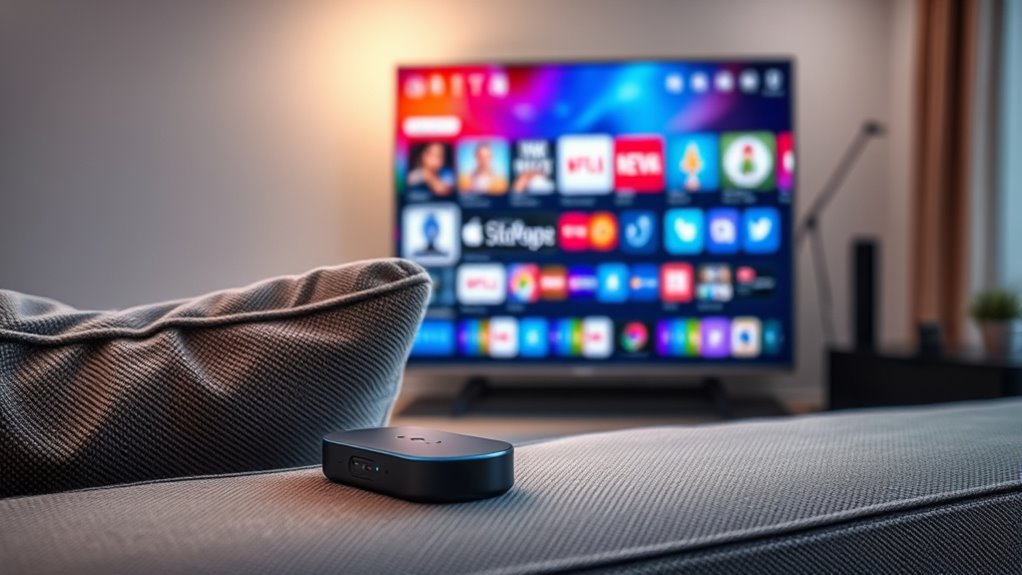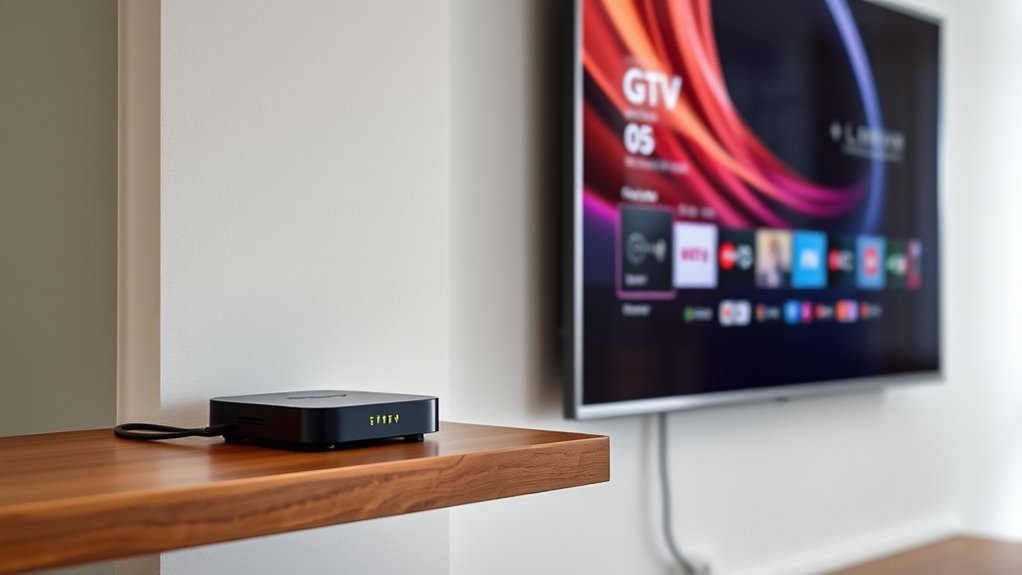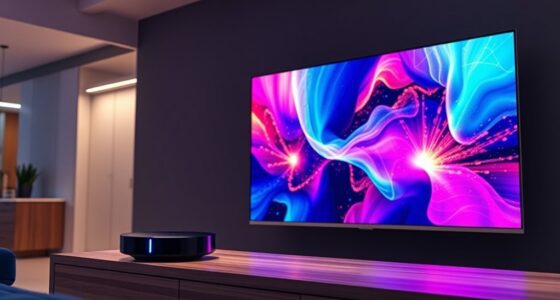Whether you need a separate device depends on what you value. Smart TVs are convenient, with built-in apps and easy setup, but they can be slow and may not update well over time. External streamers connect via HDMI, offering faster performance, better updates, and more flexibility for upgrading. If you want top performance and future-proof features, a streamer might be best. Keep exploring to discover the key differences and find the perfect setup for you.
Key Takeaways
- External streamers often provide faster app loading and smoother performance than built-in Smart TV apps.
- Smart TVs offer convenience with integrated apps and automatic updates, reducing clutter and setup time.
- External streamers are upgradeable independently, ensuring better compatibility with new streaming formats and features.
- Smart TVs may have limited software updates, potentially becoming outdated or sluggish over time.
- Using an external streamer can enhance security, privacy, and future-proof your streaming setup.

When choosing how to stream your favorite shows, you might wonder whether a Smart TV or an external streamer is the better option. Both choices have their advantages, but understanding their differences can help you make the right decision for your setup. A Smart TV comes with built-in apps and internet connectivity, giving you the convenience of accessing streaming services directly on your TV without extra devices. This means fewer wires, less clutter, and a straightforward setup. If you’re someone who prefers simplicity and wants to turn on the TV and immediately start watching, a Smart TV can be a good choice. You won’t need to worry about purchasing or managing additional devices, and updates are often handled automatically through the TV’s firmware.
Choosing between a Smart TV and an external streamer depends on your preferences for simplicity or customization.
However, Smart TVs can vary in performance and user interface quality. Some models may have slow app loading times, limited app selections, or outdated software. Over time, their operating systems might become sluggish or less supported, requiring a new purchase sooner than you’d like. If you’re tech-savvy and enjoy customizing your streaming experience, a Smart TV’s integrated platform could feel limiting or frustrating. Plus, if you already own a good-quality external streamer, investing in a new Smart TV might be redundant.
External streamers, on the other hand, are dedicated devices like Roku, Amazon Fire TV, Apple TV, or Chromecast, which connect to your existing TV via HDMI. They often provide a more robust and user-friendly interface, with faster updates and access to a broader range of apps. External streamers are typically more powerful than Smart TV apps, leading to quicker navigation and smoother streaming. They also tend to support higher resolutions and advanced features like HDR or Dolby Vision, which can enhance your viewing experience. If you’re someone who likes to keep up with the latest streaming technology, an external device can be upgraded independently of your TV, giving you more flexibility.
Another benefit is that external streamers are generally compatible with multiple TVs, so you can switch them between rooms or upgrade without replacing your entire television. They also tend to have better privacy controls and security features, which can be a concern with some Smart TVs that collect data or run outdated software. While they require a bit more setup — plugging in the device and connecting it to Wi-Fi — most users find the improved performance and features worth the extra step. Ultimately, if you’re seeking a more versatile, future-proof, and often more reliable streaming experience, an external streamer is worth considering, especially if your current TV doesn’t have the apps or speed you want.
Frequently Asked Questions
Can a Smart TV Replace All External Streaming Devices?
You might wonder if a smart TV can replace all external streaming devices. While smart TVs offer built-in apps for popular streaming services, they may lack the latest features or app updates. External streamers often provide faster performance, broader app support, and future-proofing. So, if your smart TV’s capabilities meet your needs, you might not need an extra device. Otherwise, a dedicated streamer can enhance your viewing experience.
Do External Streamers Support 4K and HDR Content?
External streamers like Roku, Fire TV, and Apple TV support 4K and HDR content, giving you high-quality visuals. They’re designed to handle advanced video formats, so you get crisp images and vivid colors. If your TV doesn’t already support 4K or HDR, adding an external streamer can upgrade your viewing experience. Just make sure to verify the device specifications to confirm compatibility with your preferred content and display.
Are External Streamers More Secure Than Smart TVS?
Think of your streaming setup like a house security system. External streamers often get security updates faster and have fewer vulnerabilities, making them more secure than smart TVs, which can have more built-in features but also more entry points for hackers. For example, a friend’s smart TV was hacked through a vulnerable app, but an external streamer remained secure after updates. So, yes, external streamers tend to be more secure.
How Does Latency Compare Between Smart TVS and External Streamers?
Latency varies between smart TVs and external streamers, often depending on your setup. External streamers generally have lower latency because they process and transmit signals more efficiently, reducing lag. Smart TVs might introduce more delay due to built-in processing. If you’re into fast-paced gaming or live sports, an external streamer can give you a smoother experience. So, if low latency matters, an external device usually outperforms a smart TV’s built-in system.
Is It Cost-Effective to Buy an External Streamer?
Back in the day, buying a separate streamer might seem like an extra expense, but it can be cost-effective now. If your smart TV’s apps are slow or outdated, an external streamer boosts performance and gives you access to more apps and features. Plus, it’s usually cheaper than replacing the whole TV. So, if you want better streaming quality without breaking the bank, an external device is a smart choice.
Conclusion
Ultimately, choosing between a smart TV and an external streamer is like picking between a Swiss Army knife and a dedicated tool—you get versatility either way. If you want simplicity and all-in-one convenience, a smart TV might be your best bet. But if you crave customization and the latest apps, an external streamer can be your secret weapon. Whichever path you choose, remember, the right device can turn your living room into a blockbuster theater—your entertainment, your rules.















